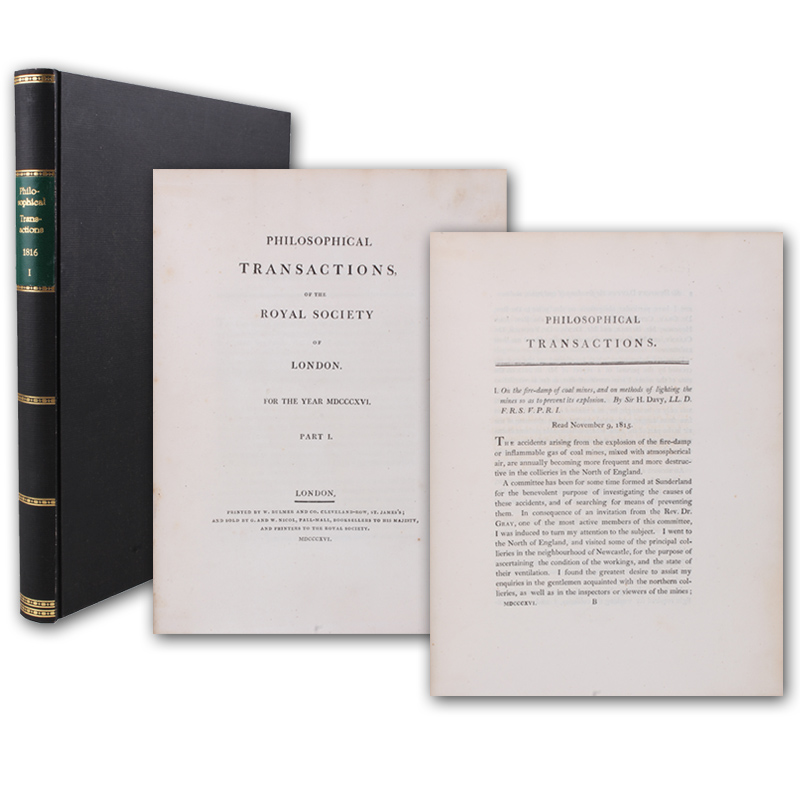112552-01
On the fire-damp of coal mines, and on methods of lighting the mines so as to prevent its explosion. SS. 1-22 mit 1 Tafel. - Und: Derselbe. An account of an invention for giving light in explosive mixtures of fire-damp in coal mines, by consuming the fire-damp. SS. 23-24. In: Philosophical Transactions of the Royal Society of London for the Year MDCCCXVI. Part I.
London, Bulmer, 1816. - (28 x 22,5 cm). VI (2) 178, 26 S. Mit 10 Kupfertafeln, davon 1 gefaltet. Moderner Pappband im Stil der Zeit.
Erste Ausgabe der Beschreibung seiner berühmten Sicherheitslampe, ein Meilenstein in der angewandten Chemie. - "On his return to England in 1815, Davy was asked to turn his attention to the explosions in coal mines, which had recently been the cause of a number of disasters. He visited Newcastle-on-Tyne in August 1815 and arranged for samples of the explosive gas firedamp to be sent to him at the Royal Institution. He confirmed that methane was the main constituent and independently confirmed the observations of Tennant and Wollaston that this gas could be ignited only at a high temperature. Because of this it will not communicate flame through a narrow tube of sufficient length; the cooling effect of the tube is too great. Davy contructed lamps in which the air intake and the chimney were composed of narrow tubes, and found that they did not explode firedamp. He then found that wire gauze was equally efficient; and the Davy lamp, in which the flame is surrounded by wire gauze, was born.The whole research occupied less than three months, and is an example of Davy at his best. It led to research on flame, in which he concluded that luminosity is due to the presence of solid particles" (DSB). - Die Tafeln stärker wasserrandig. Der Text sauber und gut erhalten. - DSB 3, 598; Dibner 181
On the fire-damp of coal mines, and on methods of lighting the mines so as to prevent its explosion. SS. 1-22 mit 1 Tafel. - Und: Derselbe. An account of an invention for giving light in explosive mixtures of fire-damp in coal mines, by consuming the fire-damp. SS. 23-24. In: Philosophical Transactions of the Royal Society of London for the Year MDCCCXVI. Part I.
London, Bulmer, 1816. - (28 x 22,5 cm). VI (2) 178, 26 S. Mit 10 Kupfertafeln, davon 1 gefaltet. Moderner Pappband im Stil der Zeit.
Erste Ausgabe der Beschreibung seiner berühmten Sicherheitslampe, ein Meilenstein in der angewandten Chemie. - "On his return to England in 1815, Davy was asked to turn his attention to the explosions in coal mines, which had recently been the cause of a number of disasters. He visited Newcastle-on-Tyne in August 1815 and arranged for samples of the explosive gas firedamp to be sent to him at the Royal Institution. He confirmed that methane was the main constituent and independently confirmed the observations of Tennant and Wollaston that this gas could be ignited only at a high temperature. Because of this it will not communicate flame through a narrow tube of sufficient length; the cooling effect of the tube is too great. Davy contructed lamps in which the air intake and the chimney were composed of narrow tubes, and found that they did not explode firedamp. He then found that wire gauze was equally efficient; and the Davy lamp, in which the flame is surrounded by wire gauze, was born.The whole research occupied less than three months, and is an example of Davy at his best. It led to research on flame, in which he concluded that luminosity is due to the presence of solid particles" (DSB). - Die Tafeln stärker wasserrandig. Der Text sauber und gut erhalten. - DSB 3, 598; Dibner 181
750 €

